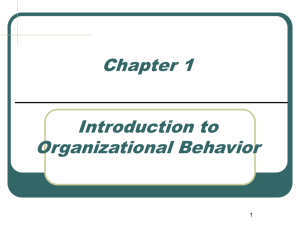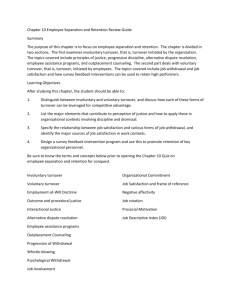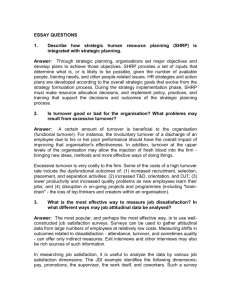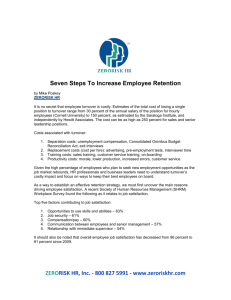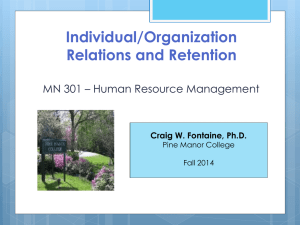chapter 2
advertisement
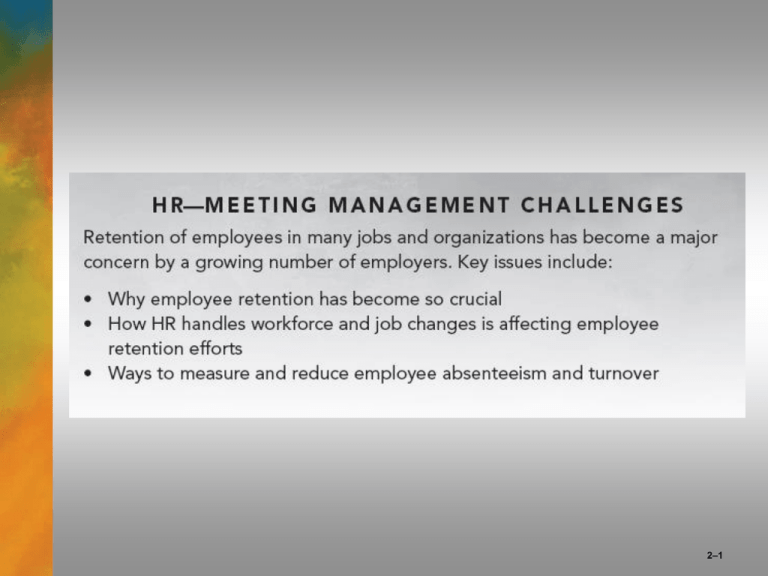
2–1 The Psychological Contract • Employers provide: Competitive compensation and benefits Flexibility to balance work and home life Career development opportunities • Employees contribute: Continuous skill improvement and increased productivity Reasonable time with the organization Extra effort when needed 2–2 Job Satisfaction, Loyalty, and Commitment • Job Satisfaction A positive emotional state resulting from evaluating one’s job experience. • Loyalty and Organization Commitment The degree to which employees believe in and accept organizational goals and desire to remain with the organization. Employee engagement: the extent to which an employee is willing and able to contribute. Continuance commitment: the likelihood that an individual will stay with rather than withdraw from the organization. 2–3 Figure 2.1 Factors Affecting Job Satisfaction and Organizational Commitment 2–4 Individual Employee Performance • Individual Performance Factors Individual ability to do the work Effort level expended Organizational support Performance (P) = Ability (A) x Effort (E) x Support (S) 2–5 Components of Individual Performance 2–6 FIGURE 2.2 Drivers of Retention 2–7 Jobs and Retention Job Performance Job Satisfaction Job Design and Person/Job Fit Physical and Mental Health 2–8 Approaches to Job Design/Redesign • Job enlargement • Job enrichment • Job rotation • Person/job fit 2–9 Figure 2-3 Some Characteristics of People and Jobs 2–10 Using Teams in Jobs • Jobs assigned to teams of employees Team leaders develop • Global teams Meet electronically • Teams are likely to be successful if: They have authority to make decisions 2–11 Figure 2-3 Managing Retention 2–12 Employee Absenteeism • Absenteeism Any failure to report for work as scheduled or to stay at work when scheduled. Involuntary absenteeism Unavoidable with understandable cause (e.g., actual illness) Voluntary absenteeism Avoidable without justifiable cause (e.g., feigning illness) 2–13 Figure 2-5 Employee Absenteeism Controls 2–14 Employee Turnover • Turnover The process in which employees leave the organization and have to be replaced. • Types of Turnover • Involuntary turnover—terminations for poor performance or work rule violations. • Voluntary turnover—employees leave by choice. • Functional turnover—lower-performing or disruptive employees leave the organization. • Dysfunctional turnover—key individuals and high performers leave at critical times. • Uncontrollable turnover—employees leave for reasons outside the control of the organization. • Controllable turnover—occurs due to factors that could be influenced by the employer. 2–15 Employee Turnover • Reasons for Turnover 1. The employee moves out of the geographic area. 2. The employee decides to stay home with young children or elder relatives. 3. The employee’s spouse is transferred. 4. The employee is a student worker who graduates from college. 2–16 HR Metrics • HR Metrics: Measuring Absenteeism Incidence rate Inactivity rate Severity rate Number of person - days lost throu gh job absence during period 100 (Average number of employees) (Number of work days) 2–17 HR Metrics • Ways to Measure Turnover: Job and job levels Department, unit, and location Reason for leaving Length of service Demographic characteristics Education and training Knowledge, skills, and abilities Performance ratings/levels • Computing the Turnover rate: Number of employee separation s during the month 100 Total number of employees at midmonth 2–18 HR Metrics • Costs of Turnover Separation costs Replacement costs Training costs Hidden costs 2–19 Figure 2-6 Simplified Turnover Costing Model 2–20
